Wat Mahathat Yuwarat Rangsarit
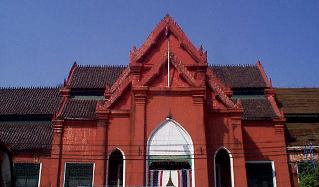
Department is building in area of Wat Mahathat
Wat Mahathat which is a royal temple of the first grade is
situated to the north of the Royal Palace, having Sanam Luang (the Phra Men
Ground) on its eastern side. It was built in the Ayutthaya period and called
Wat Salak. The revition of the Tripitaka (the Buddhist Canon) took place at
this temple in A.D. 1788. In A.D. 1803 after the death of the Prince of the
Palace to the Front, King Rama I arranged a meeting of high ranking monks to
set up an examination system for monks and novices. King Rama V in A.D. 1896
donated the wealth of His Royal Highness the Crown Prince Maha Vajirunahis who
died in A.D. 1894 to complete the renovation of the Temple.
Important Objects in the Temple
1. Mondop
This was built when the first Prince of the Palace to the Front renovated the
temple.
The superstructure of the original Mondop which was in the shape of a
prasat-root, wastaken from the prasat built in the Palace of the Front. This
Mondop was built to house a golden stupa which contains relic of the Buddha.
Later the roof of the Mondop was destroyed by fire and a new roof was made in
an ordinary form. The Mondop was repaired during the reigns of King Rama III
and King Rama IV.
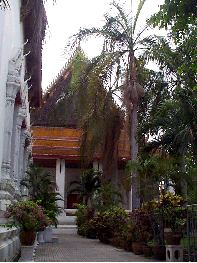
The Mondop with the Ordination Hall in its front. Its unique style is that
there are no front nor rear porch and all the boundary stones installed in the
niches of the outer and inner walls.
2. The Ordination Hall and Wihan
The original ones were burnt down at the same time as the Mondop in A.D. 1801.
The Prince of the Palace to the Front rebuilt them. It is believed that he
whole temple was pulled down to be rebuilt in a grand scale at that time. The
wall of the Ordination Hall was expanded as far as to the boundary stone slabs.
As result the New Ordination Hall is nearer to the Mondop and the boundary
stone slabs are fixed into the walls. The New Wihan was built in the same style
as the old one.
On the gable of the Wihan, the motif is of a small crown, the insignia of the
Crown Prince, beautifully decorated with lacquer and glass mosaic.
3. Prangs and Chedis in Rows
In the northern gallery of the Wihan and the south of the Ordination Hall there
are two Chedis and Prang on each side. They were built in the period of King
Rama I and covered with in. When they were repaired during the reign of King
Rama III, the tin cover was taken off as they are seen now. Another two Prangs
were built, one next to the other, in the north of the compound. They were
later removed and rebuilt ouside the northern gallery during the reign of King
Rama III.
The two large Prangs within the galleries in front of the mondop were built
during the reigns of King Rama II. It is believed that one of them contains the
remains of the Supreme Patriarch named Suk and the other, that of another
Supreme Patriarch called Mi.
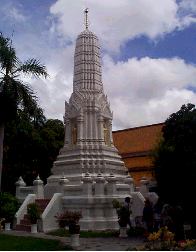
The Main Prang within the galleries in front of the Mondop and four Buddha
images standing in the alcove at four sides of the Main Prang
4. The Supreme Patriarch's Abode
In A.D. 1794 the Venerable Si of Wat Rakhang, the first Supreme Patriarch of
Bangkok, died; King Rama I nominated Phra Banaratana named Suk of Wat Mahathat
as the second Supreme Patriarch. He took residence at this temple which is
situated between the Grand Palace and the Palace to the Front and was more
important than Wat Rakhang. Since then Wat Mahathat has been the resdence of
several Supreme Patriarch.
The resdence of the Supreme Patriarch was probably built in A.D. 1793 when the
second Supreme Patriarch first came to this temple. Some more buildings were
added during the reign of King Rama II since two groups of buildings were there
when King Rama III repaired the temple.
In A.D. 1896 King Rama V donated the wealth of the Crown Prince who had passed
away for the renovation of the temple. The whole group of the Supreme
Patriarch's abode was renovated. It had been vacant since the Supreme Patriarch
Phra Buddhakhosachan named Chim died during the reign of King Rama IV and had
been used to store the decorations of the deceased royalty. It later became the
residence of the abbot of the temple.
5. Images of the Buddha
The main Buddha images in the Ordination Hall and Wihan are in brick and
mortar. The image in the Ordination Hall was renovated and enlargen during the
reign of King Rama III to go with the Hall which was also enlarged, without any
change of the style of the image.
Beside these there are 28 more old bronze Buddha images, seated in alteration
with the standing, inside the Mondop on four sides. The number of the images is
equal to that of Buddhas already born in this age.
There are eight images of Arahants (enlighthened disciples) surrounding the
main Buddha image in the Ordination Hall, each of which has his name engraved
at the base.
The Buddha images inside the gallery on four sides are 108 in number, not
counting the four at the corner which are believed to be constructed in later
times.
Almost all of the old bronze Buddha images inside the Mondop and Wihan which
were mentioned earlier are of Sukhothai style; only the five standing images
inside the Mondop are Uthong Style.
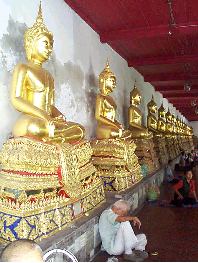
108 Buddha images along the cloister
This is a small Wihan built during the reign of King Rama IV, where he stayed
when he was a monk. It is to the east of the sacred Bodhi tree which was
planted by King Rama II. The wall of the Wihan and the lower part of the trunk
of the tree are joined together. The floor inside the Wihan is made of marble.
Later in A.D. 1896, he announced the change of name to "Maha Chulalongkorn
Ratchawitthayalai" to commemorate his name. He began the construction of the
building of it, but he passed away before it was completed. The building later
became the National Library and at present it houses the Division of
Architecture of Fine Arts Deprtment.
The present building of Maha Chulalongkorn Ratchawitthayalai was built in A.D.
1956 to the north of the Supreme Patriarch's abode.
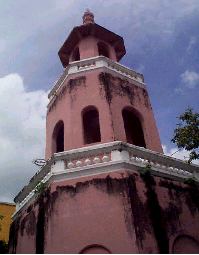
The Bell Tower stands southern the Wihan
7. Maha Chulalongkorn Ratchawitthayalai
This is an advanced institute of learning for monks, organized in the same way
as a university. It was founded in A.D. 1889 by King Rama V with the intention
to provide an educational institute for monks of Mahanikaya fraternity, in the
same way as Maha Mongkut Ratchawitthayalai was for the monks in the
Dhammayattika fraternity. It was the first time that the word Witthayalai or
University was used in Thai vocabulry.
8. Monument of Somdej Kroma Phraratchwangbowon Mahasurasinghanath
(The First Prince of the Palace to the Front)
Wat Mahathat is open daily from 9.00 am to 5.00 pm. Admission is free.
|